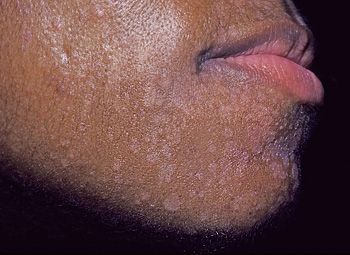- Clinical Technology
- Adult Immunization
- Hepatology
- Pediatric Immunization
- Screening
- Psychiatry
- Allergy
- Women's Health
- Cardiology
- Pediatrics
- Dermatology
- Endocrinology
- Pain Management
- Gastroenterology
- Infectious Disease
- Obesity Medicine
- Rheumatology
- Nephrology
- Neurology
- Pulmonology
Seborrhea
A 27-year-old woman asks about slightly itchy and scaly “white spots” on her face. She has rather severe dandruff, which requires shampooing every other day for control.

A 27-year-old woman asks about slightly itchy and scaly “white spots” on her face. She has rather severe dandruff, which requires shampooing every other day for control.
Key point: Seborrhea usually presents as a scaling erythema on the face, behind the ears, in the scalp, and occasionally on the body. However, the morphology in this patient is a rather distinct appearance of seborrhea on skin of color. Involvement of the face may or may not be concurrent with scalp involvement.
Treatment: Use of an antifungal azole cream, particularly ketoconazole, is the first therapeutic option. Low-potency corticosteroid preparations may also be useful. If scalp disease is present, control via ketoconazole, selenium sulfide, or low-potency corticosteroid-containing shampoos is indicated.
Note: A potassium hydroxide preparation of the scale is a good idea, since tinea versicolor can exactly mimic seborrhea on the face, especially in African American patients.
FDA Approves Guselkumab for Pediatric Plaque Psoriasis and Active Psoriatic Arthritis
September 30th 2025The FDA has approved guselkumab for children aged 6 years and older with moderate to severe plaque psoriasis or active psoriatic arthritis, making it the first IL-23 inhibitor authorized for pediatric use.
